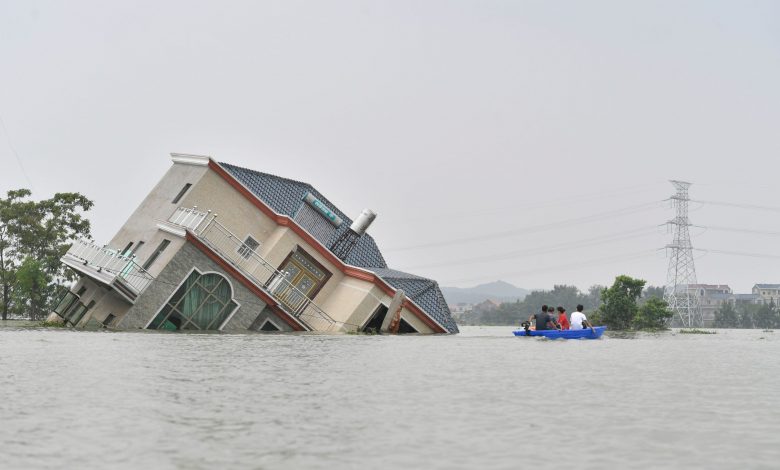Climate Change Is Exposing Millions Of People To High Risk Floods
Proportion of population exposed to floods has grown by 24% globally since the turn of the century

A New research published recently in Nature used direct satellite observations of floods, rather than the standard modeled estimates, to reveal that the proportion of population exposed to floods has grown by 24% globally since the turn of the century – ten times higher than scientists previously thought – due to both increased flooding and population migration.
This marks an increase of population inside flood-prone regions of up to 86 million people. This research was led by scientists at Cloud to Street, a global flood tracking and risk analytics platform for disaster managers and insurers, with co-authors from NASA, Google Earth Outreach, University of Arizona, Columbia University, University of Michigan, University of Colorado, University of Texas at Austin, and the University of Washington.
Cloud to Street will openly host the The Global Flood Database, the database behind the Nature paper, which is the largest and most accurate dataset of observed floods ever produced, providing a new view into the true scope of flooding.
Link to Visit The Global Flood Database to visualize all floods : global-flood-database.cloud street.ai.

58-86 million people moved into observed flood regions between 2000-2015, a 20-24% increase in the proportion of population exposed to floods. – 2.23 million square kilometers (~861,000 square miles) were flooded between 2000-2018, affecting between 255 and 290 million people. – By 2030, our model estimates that climate and demographic change will add 25 new countries to the 32 already experiencing increasing floods. – Despite representing less than 2 percent of floods, dam breaks had the highest increased incidence (177%) in proportion of population exposed. – Population growth in flooded areas is driven by people moving into flood-prone areas— and economic development in those regions. Vulnerable populations often have no choice but to settle in flood zones. – Nearly 90% of flood events occurred in South and Southeast Asia, with the large basins (Indus, Ganges-Brahmaputra, and Mekong) having the largest absolute numbers of people exposed and increased proportions of population exposed to inundation.
Professor Saleemul Huq- Director, International Centre for Climate Change and Development (ICCCAD)and Senior Associate IIED, Imperial College of London-
“The new IPCC report is not a drill but the final warning that the bubble of empty promises is about to burst. G20 countries rapidly need to switch gears and this time stick to the pledges of delivering policies that ensure that we don’t exceed 1.5°C warming by the end of the century. It’s suicidal, and economically irrational to keep procrastinating. The course of action is crystal clear.”
The satellite date also uncovered previously unidentified increases in flood exposure in Southern Asia, Southern Latin America, and the Middle East. Most flood events in the database were caused by heavy rainfall, followed by tropical storms or surges, then snow or ice melt, and then dam breaks. For example, in August 2008 the collapse of the Koshi Barrage left over 3 million people homeless in Bihar, India. In 2018, the opening of the Bagre Dam in Burkina Faso flooded thousands of hectares of agricultural land in Ghana, contributing to food insecurity. These incidents illustrate the increasingly deadly cost of failing infrastructure.
The west bengal and Bihar including sevral cities from UP such as- Varanasi, Mirzapur, Prayagraj Hamirpur,Auraiya, Etawah, Morena etc. , region of India is showing a 97.3% increase in population exposed to flooding between 2000 to 2015.
Climate change projections for 2030 indicate that the proportion of the population exposed to floods will increase further. The high spatial and temporal resolution of the satellite observations will improve our understanding of where floods are changing and how best to adapt. The global flood database generated from these observations will help to improve vulnerability assessments, the accuracy of global and local flood models, the efficacy of adaptation interventions and our understanding of the interactions between landcover change, climate and floods.
Sonam P Wangdi of Bhutan, Chair of Least Developed Countries Group at UN Climate Change Conference-COP26
“Alarm bells are ringing; I hope everyone is hearing them. We need to see developed countries and large emitters take the lead and slash emissions, and we need the assurance that this will happen urgently. More ambitious NDCs that close the emissions gap must be submitted by COP26. G20 countries have made this commitment, now they must deliver. Resubmitting the same NDC is not enough – we clearly need stronger emissions reduction targets for 2030. We really are running out of time. Climate change is hurting our countries and communities worst. It’s already late but by COP26, developed countries must deliver their decade-old commitment to provide $100bn annually and keep on increasing it as per the needs of countries facing climate impacts.”
With funding from Google Earth Outreach, flood mapping experts Cloud to Street and the DFO Flood Observatory combined 15+ years of flood data with human settlement data to create a comprehensive database for researchers, humanitarian workers, community organizations, and insurance and finance providers.
Views expressed here are those of Dr. Seema Javed, a known Environmentalist, Journalist and Communications Expert




